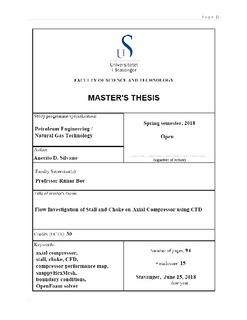| dc.contributor.advisor | Bøe, Runar | |
| dc.contributor.author | Silvano, Anecito | |
| dc.date.accessioned | 2018-10-24T12:48:06Z | |
| dc.date.available | 2018-10-24T12:48:06Z | |
| dc.date.issued | 2018-06 | |
| dc.identifier.uri | http://hdl.handle.net/11250/2569358 | |
| dc.description | Master's thesis in Petroleum Engineering | nb_NO |
| dc.description.abstract | The complicated nature of axial compressor fluid dynamics instabilities such as stall and choke when utilizing air power left a lot of room for investigation during the state of operation. This dynamic instabilities diminished compressor efficiency, reliability, and even loss of engine power leading to catastrophic failure. Therefore, it is extremely important to understand how choke and stall occurs and the causes behind its inception.
The interactions between the shock wave and the tip clearance flow have been identified as the primary cause of stall. Thus, to explore its flow mechanisms and the physical trends as compressor throttle towards stall, fundamental questions are have to be answered in the course of investigation. These questions are the following:
How does the rotor blade tip clearance flow affects shock wave during interactions?
Does shock boundary layer leading to shock waves causes flow separation?
What is the possible behavior of both the shock wave and the rotor tip clearance flow?
Investigation rolls around NASA Rotor 67, a transonic axial compressor turbo rotor fan, operated without inlet guide vane(IGV) and stator. This rotor-only configuration enables comparison of its experimental data(A. J. Strazisar et. al., 1989) and the numerical flow analysis using computational fluid dynamics(CFD) simulation in OpenFOAM. Thus, actual application of fluid dynamics physical laws and theories into CFD tool is the main take-away of the author's academic gain on this study.
A three-dimensional unsteady Navier-Stokes equations and proper set of stable and accurate boundary conditions were studied and applied. The flow case was scrutinized to select proper solver and turbulence model. The OpenFOAM solver, rhoPimpleDyMFoam, and the k-ω-SST turbulence model applied to Approximate Reimann(ARS) solver fits the case showing good convergence with resulting flow field in agreement with the experiment.
Compressor performance map operating points(peak efficiency condition, near stall and stalled condition) were thoroughly investigated on the simulation by studying the flow fields in the rotor tip region. It is found that the interaction between the shock wave and the rotor blade tip vortex leakage flow is mainly the reason behind the stall of axial compressor. | nb_NO |
| dc.language.iso | eng | nb_NO |
| dc.publisher | University of Stavanger, Norway | nb_NO |
| dc.relation.ispartofseries | Masteroppgave/UIS-TN-IEP/2018; | |
| dc.subject | petroleumsteknologi | nb_NO |
| dc.subject | petroleum engineering | nb_NO |
| dc.subject | axial compressor | nb_NO |
| dc.subject | stall | nb_NO |
| dc.subject | compressor performance map | nb_NO |
| dc.subject | OpenFoam Solver | nb_NO |
| dc.subject | snappyHexMesh | nb_NO |
| dc.title | Flow Investigation of Stall and Choke on Axial Compressor using CFD | nb_NO |
| dc.type | Master thesis | nb_NO |
| dc.subject.nsi | VDP::Teknologi: 500::Berg‑ og petroleumsfag: 510::Petroleumsteknologi: 512 | nb_NO |
